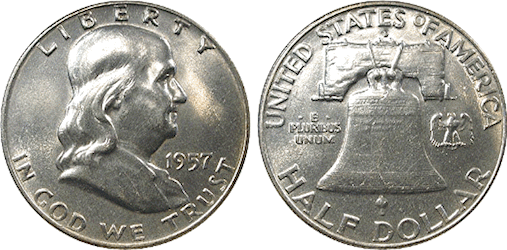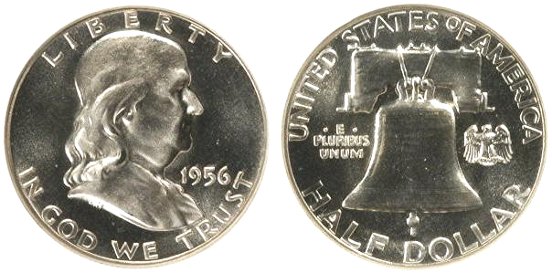
The short-lived Franklin half dollar series has quickly become forgotten and neglected. The golden era of coins came to an end in 1947, when the Walking Liberty half dollar was replaced by the Franklin half. Ben Franklin joined Lincoln (cent), Jefferson (nickel), FDR (dime) and Washington (quarter). For the first time in history, every coin had a portrait of a historical figure. The Benjamin Franklin half dollar is a Philadelphia favorite. Philadelphia resident Benjamin Franklin is on the obverse, while the Philadelphia icon, the Liberty Bell is on the reverse.
Sinnock’s silliness
The Franklin half dollar and the Roosevelt dime were both designed by John Sinnock. The liberty bell on the reverse of the coin closely resembles an earlier design of Sinnock’s: the 1926 commemorative sesquicentennial of American independence half dollar. According to law, all coins of denomination twenty five cents and higher were requried to depict an American Eagle. The walking liberty half dollar featured a perched eagle which filled the coin’s reverse. Sinnock must be given credit for fulfilling the letter of the law in the most minimalist fashion imaginable. Our nation’s bird bears a closer resemblance to a housefly or a bat than an eagle. It sits alone in the field to the right of the liberty bell.
Collecting Franklin half dollars
The Franklin half series is relatively easy to collect. The series only ran for 16 years. A complete set of regular issues consists of only 35 coins. In circulated conditions, none of the dates are truly rare. Even the scarcest dates had mintages of around three million. In uncirculated condition the 1949D and 1949S can be elusive. Franklin halves tend to be weakly struck. Coins in which the bell lines are fully struck (designated as “full bell lines”) are often worth considerably more than the typical lazily struck halves.
Proof Franklin halves

Proof Franklin half dollars were struck each year starting in 1950. Proofs from the early years. By the 1960’s, as coin collecting started booming as a hobby, the mint was making several million proofs per year.
About Benjamin Franklin
Franklin conducted many experiments on electricity including his famous foolhardy experiment of holding a kite in a lightning storm. His inventions include the Franklin stove, bifocal glasses, and the lightning rod. As an author and printer, he published the Poor Richard's Almanack
using the pen name “Richard Saunders.” His book, The Autobiography Of Ben Franklin
is considered one of the first classic autobiographies
Franklin’s coin pun
In response to a call for scientific papers, Franklin sent a proposal to the Royal Academy of Brussels on experiments to improve the odor of human flatulence. He stated that “compared to the practical applications of this discussion, other sciences are scarcely worth a Fart-hing" which is, of course, a play on the word for the British coin.
This work is included in the collection, Fart Proudly: Writings of Benjamin Franklin You Never Read in School
.